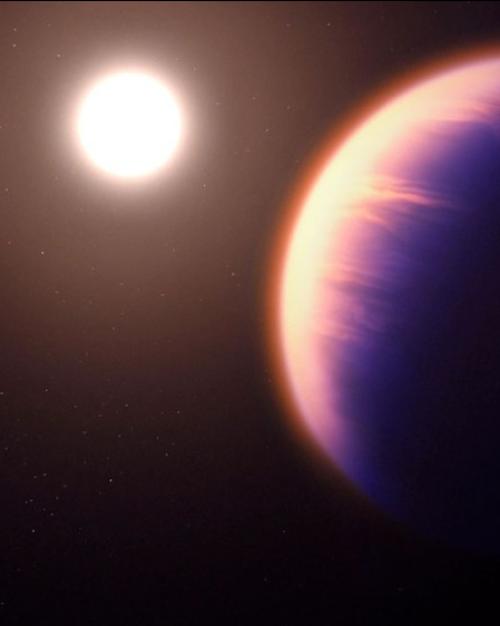NASA’s powerful James Webb Space Telescope opens a new chapter in scientific history, as a large international team – including several Cornell astronomers – found molecular evidence of carbon dioxide on the exoplanet WASP-39b, a giant gaseous world orbiting a sun-like star about 700 light-years away.
The international group’s findings, supported by hundreds of scientists across dozens of institutions, marks a key milestone for the telescope and exoplanet exploration.
Their work was accepted for publication in Nature.
“Carbon dioxide is important in the atmospheres of rocky solar system planets like Earth and we expect it to be important to exoplanet atmospheres, as well,” said Laura Flagg, a postdoctoral researcher in the research group of Ray Jayawardhana, the Harold Tanner Dean of the College of Arts and Sciences, and the Hans A. Bethe Professor and professor of astronomy.
“Until now, we couldn’t detect carbon dioxide on exoplanets,” Flagg said. “We didn’t have evidence. We couldn’t confirm it. Not only did this team confirm it by using a spectrum, but they confirmed it easily.”
The exoplanet WASP-39 b is a gas-giant planet with a mass about 94% the size of Saturn and a diameter 1.3 times larger than Jupiter. It orbits its own sun every four days from 4.5 million miles away, about one-eighth the distance of Mercury to our own sun. Not only is this planet extremely hot, but it is tidally locked – meaning, one side always faces its sun.
Ryan MacDonald, a postdoctoral researcher in the laboratory of Nikole Lewis, associate professor of astronomy in the College of Arts and Sciences, had advocated for using the telescope’s Near Infrared Spectrograph, as it could absorb a wide array of color and analyze tiny differences in brightness. He felt WASP-39b was an ideal target.
When data returned from the July 10 observations, scientists noticed a small bump in the spectral lines between 4.1 and 4.6 microns.
“When I finally saw the data, it was a jaw-dropping moment,” MacDonald said. “There was this whopping carbon dioxide spectral feature that you could see by eye. I knew exactly what it was. I’ve been making models for years and it was in that moment that it felt real – when I saw all those wiggles and bumps.
“We’re entering a fundamentally new era in exoplanet science,” MacDonald said. “With the telescope, we’re going to observe beautiful quality data from here on out.”
To prepare for the summer’s major scientific breakthrough moments, both Flagg and Jake Turner, a postdoctoral researcher in Jayawardhana’s group, attended a “data challenge” last spring, where researchers pored over simulated data to help prepare the core scientific team to quickly interpret downloaded telescope data.
“My reaction to this news is astonishment,” Turner said. “We’ve been working so hard for over a decade, trying to get data as clear as this. These results and other data are reasons scientists wanted to build this telescope. And this result is the tip of the iceberg. It’s only going to get better.”
Yu-Cian Hong Ph.D. ’19 is also an author on the paper.
Jayawardhana, Lewis, MacDonald, Flagg and Turner are all members of the Carl Sagan Institute in the College of Arts and Sciences, which aims to find life in the universe.
“I’m not hyperbolic when I say that this detection opens a way to start looking for life on habitable worlds,” MacDonald said.
Flagg concurred with MacDonald’s belief. “With this telescope, we’re building up a toolbox to look for potential Earth-like planets,” she said. “’Are we alone?’ is one of the most fundamental questions and we’re moving toward an answer being within the realm of possibility.”





